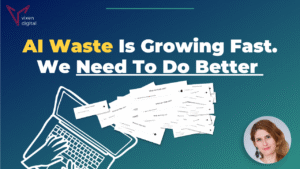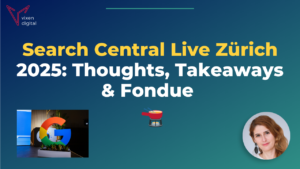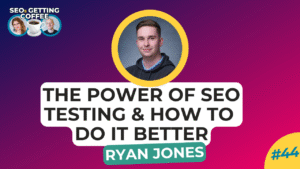In this episode of SEOs Getting Coffee hosts Sean and Emina welcome Mordy Oberstein, brand strategist, SEO veteran, and all-round straight talker, to unpack the deep (and sometimes painful) truths about the relationship between brand and SEO.
With decades of experience at companies like Semrush and Rank Ranger, Mordy doesn’t just talk about the intersection of brand and performance; he’s lived it. From the pitfalls of siloed teams to the real cost of ignoring brand positioning, this episode is a much-needed reality check for marketers who think SEO is just about keywords.
Watch Video
How brand influences SEO performance | SEOs Getting Coffee Ep.39
Brand and SEO: Not Just Friendly Neighbours
Mordy kicked things off by calling out a major issue in many organisations: performance teams and brand teams don’t talk to each other. The SEO team might own the blog, while the brand team handles landing pages, and yet both are supposedly speaking to the same audience.
But here’s the kicker: they’re often not.
Your landing pages are dripping in brand voice, while your blog is playing keyword bingo. That disconnection leads to mixed messaging and missed opportunities. The truth is, collaboration makes us better SEOs!
When Brand Declines, Performance Suffers
Mordy made a strong point: when your brand loses relevance or recognition, every performance channel feels the strain. Organic traffic becomes harder to earn. Social engagement drops. Even paid signups become more expensive.
Why? Because users don’t just need answers. They need to remember who gave them the answer.
Brand recognition builds trust and recall. Without it, you’re just another search result.
LLMs Don’t Deliver Traffic, They Deliver Brand
Large Language Models (LLMs) like ChatGPT and Google’s AI tools aren’t here to send floods of clicks to your site. They exist to give answers. If you do appear in those answers, it’s your brand that benefits, not necessarily your metrics.
This changes the KPI game. Visibility in LLMs builds brand association, not conversions. If you’re still chasing raw traffic, you might miss the real value.
The Bold Take: SEO Should Sit Under Comms
According to Mordy, SEO should sit under the communications or brand team. Why? Because the best SEO today is brand-driven. It’s not just about answering questions – it’s about aligning those answers with a clear, consistent identity.
This shift means:
- Prioritising messaging and positioning
- Aligning SEO goals with broader brand strategy
- Sacrificing short-term keyword volume for long-term brand equity
Tough sell for performance marketers, but increasingly necessary.
Why Brands Keep Getting Intent Wrong
Traditional SEO frameworks treat search intent as a neat four-bucket system. Mordy thinks that’s outdated and reductive. Real intent isn’t linear, and humans aren’t robots.
A better approach? Start with positioning.
- Who are you as a brand?
- Who are your users, really?
- Where do your identities meet?
When you understand your audience’s life context, you unlock authentic messaging, more relevant content, and deeper brand resonance.
The Positioning Problem: Most Brands Skip Step One
Brands often rush to messaging before doing the groundwork. Mordy calls this “brand therapy”- the essential soul-searching that helps you understand your identity and purpose.
Without it, your campaigns, content, and comms lack substance. Worse still, your audience notices.
A Wingstop Example You’ll Never Forget
Mordy highlighted Wingstop (yes, the chicken chain) as an example of missed positioning. Despite being a takeout brand, they never lean into messaging like “enjoy the game at home with wings”, which would resonate deeply with their actual customers.
Instead, they play it safe and broad: “where flavour gets its wings.” Catchy? Sure. Effective? Not as much.
The lesson: When you skip positioning, you miss out on relevant SEO content, targeted campaigns, and emotional resonance.
What Startups Need to Know About Brand
If you’re a startup, Mordy’s advice is clear: even if you can’t execute a full brand strategy from day one, at least understand who you are and who you want to be.
Startups often chase mass visibility, copying bigger players. But copying doesn’t create loyalty. A clear, confident identity gives you focus and gives your audience a reason to choose you.
Room 404: What Mordy Would Banish
Mordy’s Room 404 submission? GEO.
Short for “Generative Engine Optimisation,” GEO is the latest buzzword in SEO. Mordy’s take? If you’ve been doing good SEO all along, you’re already doing GEO. You don’t need a new acronym; you just need to stop doing bad work.
Fair point.
Final Thoughts
Brand and SEO aren’t separate strategies; they’re two halves of the same conversation. If your SEO is all tactics and no identity, you’re missing the point. Mordy’s challenge to the industry is simple: stop optimising for Google and start aligning with your users.
Real visibility isn’t just about rankings. It’s about relevance, resonance, and relationships.
For more insights and in-depth conversations on the latest in SEO and digital marketing strategies, stay stuned for upcoming episodes of “SEOs Getting Coffee.” Subscribe to our channel for regular updates and expert opinions.





